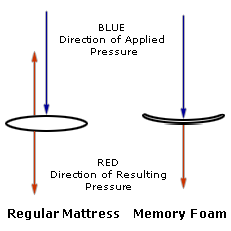The Real Benefits Of Memory Mattresses
Memory mattresses are, without a doubt, the most sought-after sleeping technology today. TV ads for a Tempur-Pedic mattress showing a disappearing hand imprint are partly responsible for their wide appeal.
We could all see the memoryfoam slowly regaining its original shape but few of us can say how that really helps us sleep better. So what is the main benefit of a memory mattress?
Memory Foam Mattress Testing And Results
Visco foam mattress manufacturers make many claims about their products. The most common ones are (paraphrased):
- Our product is comfortable thanks to its unique conforming properties and heat responsiveness
- Our product feels just like a Tempur-Pedic mattress
- Our product relieves pressure points better than air mattresses, latex mattresses and generally speaking, all other mattresses
The above claims about memory matress quality may or may not be true. Many people, for example, consider Tempur mattresses to be quite comfortable while others prefer cheaper knock offs because they feel softer. Only one claim about visco elastic mattresses, however, can be objectively tested -- their ability to relieve pressure.
How Memory Mattresses Relieve Pressure
The ability to relieve pressure points in a visco foam mattress is why Tempur-Pedic invented them in the first place and why they found success in the medical field. But how does pressure form in the first place, why should it make sleeping so uncomfortable and how do Tempur mattresses help? This is how I can best explain it.

When you lie on a regular innerspring, air or conventional foam mattress, your own body weight pulls you down. The compressed air or springs react by pushing back against you. The skin and blood vessels are caught in the middle, squeezed between the gravity force of your weight and the upwards force of the mattress.
This causes pressure points, which constricts circulation at the area of contact. The result is discomfort and even pain over time. When you lie on a memory mattress, however there is no air left in the cells to push back and cause discomfort. Air is spread to adjoining cells and the viscoelastic foam mattress simply 'melts' under you to provide long-term balanced support and comfort.
For many of us, pressure points form at the shoulder blades, buttocks, head, heels, hips and elbows which may result in numbness, stiffness or pain. In fact, this is why we toss and turn at night. This movement is our body's attempt to get more comfortable.
A visco elastic foam matress closely conforms to your unique shape, cradling the natural hollows of the human body and efficiently distributing pressure over the whole surface. This can reduce your need to turn during the night by up to a massive 80% resulting in a deeper, more restful sleep.
What Pressure Relieving Tests Say About Memory Mattresses
Pressure-mapping equipment is often used to calculate how well a visco foam mattress can distribute weight. During the mapping procedure, computer programs monitor pressure. The body's impression is graphed to show which areas endure the most pressure.
In the healthcare area, to be labeled as providing 'pressure relief' readings must be at 32mmHg or lower, whereas 'pressure reduction' performance is agreed to occur between 32mmHg and 50mmHg. So how did visco mattresses do?
A good mattress like Tempurpedic and other leading brands were shown to reduce average pressure to around 15 mmHg from nearly 30 mmHg. Cheaper clones have not been tested. No other type of mattress has achieved such low readings, making memory mattress the best pressure-relieving sleeping technology on the market.
Pressure Points Relief - The Only Documented Benefit Of Memory Foam Mattresses?
Unfortunately, reliable testing can only be done on specific memory mattress properties like pressure relief and not comfort. While it is true that this unique ability of visco mattresses results in increased comfort and better sleep quality, comfort itself cannot be tested because it is a very personal thing.
What testing has shown is that good memory foam, the heat responsive type, like the one used in Tempur Swedish mattresses, provides the most complete support and the fewest pressure points of any type of mattress.
MyFoamMattress.net is an independent buyers guide and is not affiliated with any mattress manufacturer or retailer. Different mattress manufacturers and retailers may advertise on this website but we are not affiliated with them in any way, we do not act as agents on their behalf nor are we their employees.
All care has been taken to provide consumers with unbiased information on memory foam mattresses. This may include both the pros and cons of different products and of different brands. All our content is based on extensive research on existing consumer opinions found online on countless forums, discussion groups and review sites spanning back 6 years. Our findings are meant to act exclusively as a concise summary of all these consumer opinions we have read.
About Us | Contact Us | Resources | Sitemap | Disclaimer | Privacy Policy
This website is Valid XHTML 1.0! | Valid CSS!
Copyright © 2006-2024. All rights reserved.